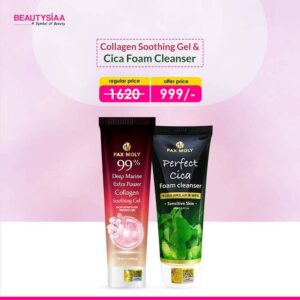Showing all 13 results
Showing all 13 results
Niacinamide in Skin Care
One of the ingredients in skin care is niacinamide. Niacinamide, or nicotinamide, is a form of vitamin B3.
- This vitamin is easily mixed with water and works with the skin’s natural ingredients.
- It is not produced in our body by itself, so we have to get it through food.
- Natural sources of niacinamide are eggs, green vegetables, beans, fish, milk, etc.
- However, it cannot be said for sure that you will get all the benefits of niacinamide for the skin by taking it.
Therefore, products containing niacinamide should be used for all skin improvements. Niacinamide is an active ingredient. I don’t know what the active ingredient is. By “active ingredients,” we mean substances that help solve specific skin problems. That does not mean that niacinamide is an exfoliator.
Niacinamide is Suitable For Which Skin Types?
Now let’s see who can use it. Niacinamide is completely safe for your skin, regardless of its type or condition. That is, if you have acne-prone, dehydrated, or even sensitive skin, you can still use niacinamide. Even pregnant and breastfeeding moms can use it. But if you are not 18 or older, then it is best not to use niacinamide or any other active ingredients. Because the sales turnover rate of teenagers is already high at this time. As a result, all of these active ingredients may irritate the skin even more.
More about this source text Source text is required for additional translation information.
What are The Benefits of Using Niacinamide?
☛ It is an ingredient with numerous advantages. Niacinamide can be just one solution to thousands of skin problems.
☛ Niacinamide helps increase the amount of ceramides in the skin, which retain or lock in moisture.
☛ Also helps build protein (keratin) in the skin.
☛ Niacinamide does not damage the skin barrier and helps reduce skin sensitivity.
☛ It hydrates dry skin. This prevents bacteria from entering the skin and reduces the chance of acne.
☛ Niacinamide helps increase collagen production. As a result, the skin becomes more youthful.
☛ Removes skin pigmentation while also evening out and smoothing skin texture.
☛ Niacinamide helps to remove dandruff. reduces acne scars.
☛ Helps minimize pores by preventing excess sebum production.
☛ So niacinamide may be the best ingredient for those with pore problems.
☛ It also helps in controlling acne. Niacinamide, being an antioxidant, helps reduce the yellowness of the skin.
☛ The sun’s harmful ultraviolet rays
☛ All the damage caused to our skin by the rays
☛ That is, it protects against free radical damage. It is not acidic, so it usually does not cause skin irritation.
Guidelines For Using Niacinamide
☛ Basic skin care must be followed when using niacinamide.
☛ After 3 months of basic skin care, you can add it to your skin care routine.
☛ Niacinamide should be used in very low percentages at first.
☛ Niacinamide at 2-5% can control the oiliness or sebum of the skin.
☛ However, it is better not to use too much niacinamide.
☛ Using niacinamide in the wrong percentages can sometimes cause purging problems.
☛ So don’t start with 10% concentration at first.The concentration can be increased if niacinamide is slowly absorbed by the skin.
☛ Niacinamide can be used day and night. Sunscreen must be used when using niacinamide.
☛ It cannot be ruled out.
The Ordinary Niacinamide
Works against anti-aging. smoothes the skin. Caution: Although the standard Niacinamide 10% + Zinc 1% works well on almost all skin types, it is most effective on those with oily skin. However, do not use serums or other products containing niacinamide and vitamin C at the same time.


















